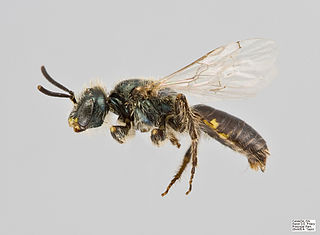
Sphaerium is a genus of very small freshwater clams, aquatic bivalve molluscs in the family Sphaeriidae, known as the fingernail clams. The small clams in this genus are unusual in that many of them, such as Sphaerium corneum, can climb around underwater on aquatic plants, using their long and strong foot.
Leptopelis bequaerti is a species of frog in the family Arthroleptidae. It is endemic to Liberia and only known from its type locality, Gbarnga, and from Mount Coffee. Common name Gbanga forest treefrog has been coined for it. It is a poorly known species with uncertain taxonomic validity.

Phrynobatrachus bequaerti is a species of frog in the family Phrynobatrachidae. It is found in the mountains of north-western Burundi, eastern Democratic Republic of the Congo, and western Rwanda. The specific name bequaerti honours Joseph Charles Bequaert, a Belgian botanist, entomologist, and malacologist and who collected the holotype from Mount Vissoke. Common name Vissoke river frog has been coined for this species.
Sphaerium bequaerti is a species of bivalve in the Sphaeriidae family. It is found in Burundi, the Central African Republic, Malawi and Tanzania. Its natural habitat is freshwater lakes.
Aethiothemis is a small genus of dragonflies in the family Libellulidae.
Aethiothemis bequaerti is a species of dragonfly in the family Libellulidae. It is found in Angola, Malawi, Nigeria, Zambia, and possibly Mozambique. Its natural habitats are subtropical or tropical moist lowland forests, subtropical or tropical dry shrubland, swamps, and marshes.

Joseph Charles Bequaert was an American naturalist of Belgian origin, born 24 May 1886 in Torhout (Belgium) and died on 12 January 1982 in Amherst, Massachusetts.
Congosaurus is an extinct genus of dyrosaurid mesoeucrocodylian. Fossils have been found from Lândana, in Angola and date back to the Paleocene epoch. In 1952 and 1964 Congosaurus was proposed to be synonymous with Dyrosaurus. The genus was later thought synonymous with Hyposaurus in 1976 and 1980. It has since been proven a distinct genus of dyrosaurid separate from both Dyrosaurus and Hyposaurus.
Baryglossa is a genus of tephritid or fruit flies in the family Tephritidae.
Baryglossa emorsa is a species of tephritid or fruit flies in the genus Baryglossa of the family Tephritidae.

Pteropurpura bequaerti is a species of sea snail, a marine gastropod mollusk in the family Muricidae, the murex snails or rock snails.

Centromyrmex is a pantropical, though mainly Afrotropical, genus of ants in the subfamily Ponerinae. This ponerine ant was recorded for the first time in French Guiana and the most northerly point of recording was in Costa Rica. The specimens reported here were collected in a region of Amazon Forest with flight interception traps.

Anthene amarah, the black-striped hairtail, leaden hairtail or leaden ciliate blue, is a butterfly of the family Lycaenidae. It is found in tropical Africa and Arabia. The habitat consists of savanna and occasionally open areas in the forest zone.
Abacetus bequaerti is a species of ground beetle in the subfamily Pterostichinae. It was described by Burgeon in 1934.

Phrynoponera is a strictly Afrotropical genus of ants in the subfamily Ponerinae.

Phrynoponera bequaerti is an Afrotropical species of ant in the subfamily Ponerinae. The species is almost as common and widespread as Phrynoponera gabonensis and by far the smallest species in the genus. P. bequaerti is easily recognized by its size, lack of clypeal teeth and short, broad funicular segments. Unlike P. gabonensis and P. sveni, P. bequaerti has not been found in termitaries.
Mallota bequaerti is a species of syrphid fly in the family Syrphidae.
Diceroprocta bequaerti is a species of cicada in the family Cicadidae. It is found in North America.

The Bequaert's miner bee is a species of miner bee in the family Andrenidae. Another common name for this species is the Bequaert's perdita. It is found in North America.
Philothamnus bequaerti, also known commonly as Bequaert's green snake, is a species of snake in the subfamily Colubrinae of the family Colubridae. The species is native to central Africa.








